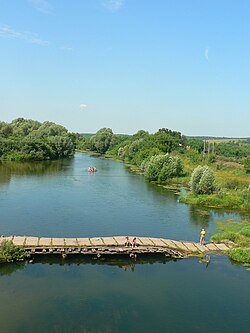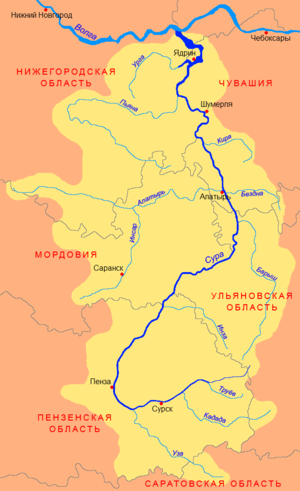The Pyana (Russian: Пья́на) is a river in Nizhny Novgorod Oblast and the Republic of Mordovia, Russia. It is a left tributary of the Sura.
| Pyana | |
|---|---|
 | |
| Location | |
| Country | Russia |
| Physical characteristics | |
| Source | |
| • location | Volga Upland |
| • elevation | 220 m (720 ft) |
| Mouth | |
• location | Sura |
• coordinates | 55°40′02″N 45°54′59″E / 55.6671°N 45.9163°E |
• elevation | 62 m (203 ft) |
| Length | 436 km (271 mi) |
| Basin size | 8,060 km2 (3,110 sq mi) |
| Discharge | |
| • average | 25 m3/s (880 cu ft/s) |
| Basin features | |
| Progression | Sura→ Volga→ Caspian Sea |

History and etymology
Pyana translates from Russian into drunken. The original name of the river was likely Piana,[1] and, like many other old Russian geographical names, might be of Uralic origin (compare Finnish pieni meaning small).[2] The most likely reason for the transformation of Piana to Pyana was the Battle on Pyana River.[3] The battle was fought on 2 August 1377 between the Blue Horde Khan Arapsha (Arab-Shah Muzaffar) and joint Russian troops under Knyaz Ivan Dmitriyevich. Awaiting the battle, the Russian Army lost discipline with drunkenness being a norm. They were unexpectedly attacked from all sides and crushed by the Mongols, forcing retreat to and across the Pyana. Many soldiers, and the Knyaz himself, drowned while crossing it.[1][4] This explanation is further supported by the original text of the chronicles of the battle, where the writer first calls the river Piana, then notes[5] the ironical similarity of the words piana and pyana (in a sense of drunkenness) and further uses Pyana as the river name.[1]
Geography and hydrology
The river is 436 kilometres (271 mi) long, and has a drainage basin of 8,060 square kilometres (3,110 sq mi).[6] It freezes around November and thaws in April. The average discharge 65 km from its mouth is 25 m³/s and it can vary between 10 and 1,500 m³/s. River banks contain numerous karst caves.[7] Pyana is remarkable by its shape: it runs to the north-west and then turns 180° south-east making a nearly closed loop (see map) before turning north and merging with the Sura.[8]
Human activities
The towns of Perevoz and Sergach are located on the Pyana. The river is navigable in its lower reaches.[7] On the river banks there is Ichalkovsky Natural Reserve of 936 ha area which is protected by the state since 1963.[9] There is a hydroelectric station near the village of Ichalkovo with the annual production of 600 MW. Its construction was started after World War II, but completed only in the 1990s.[10]
References

